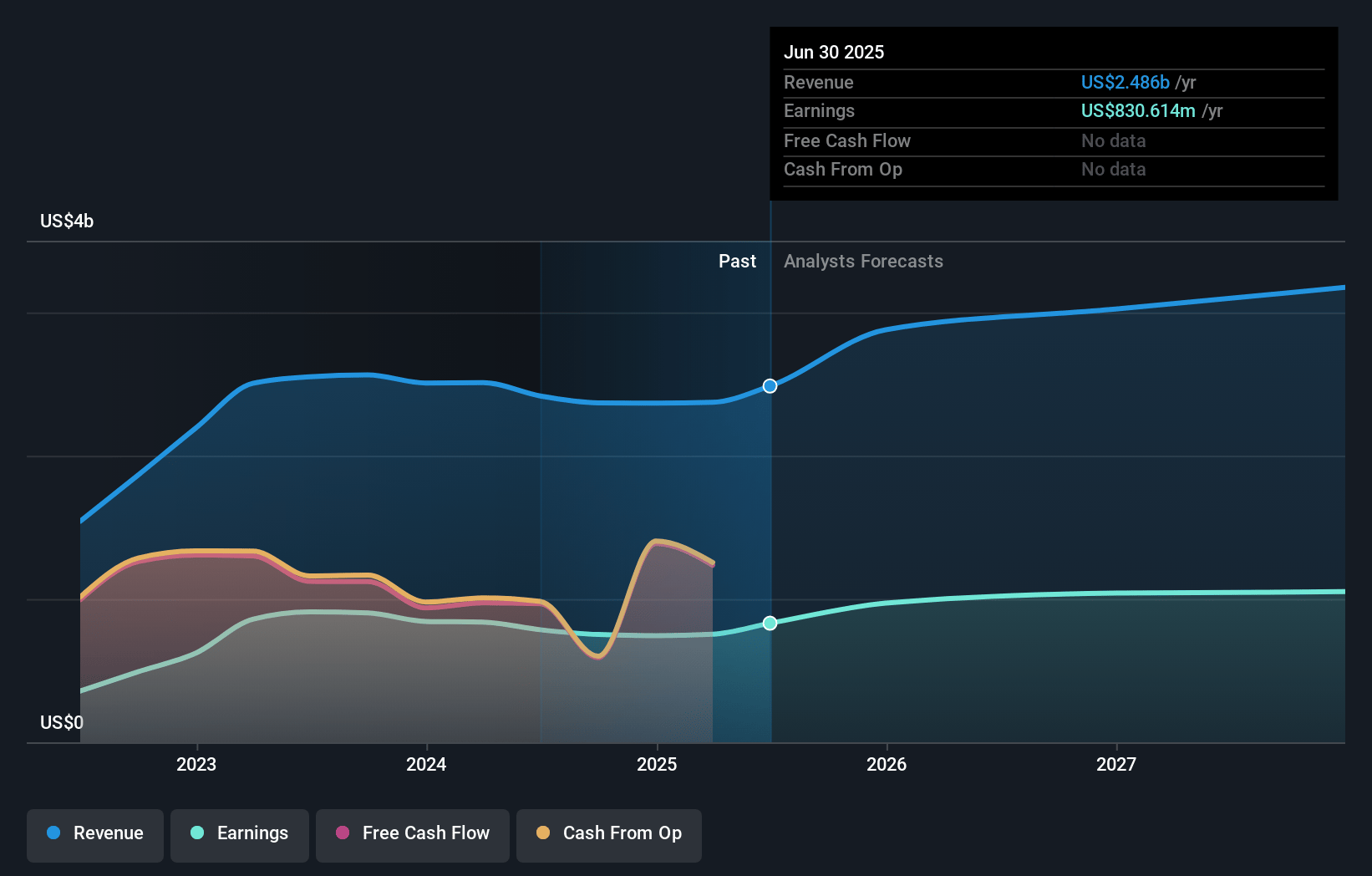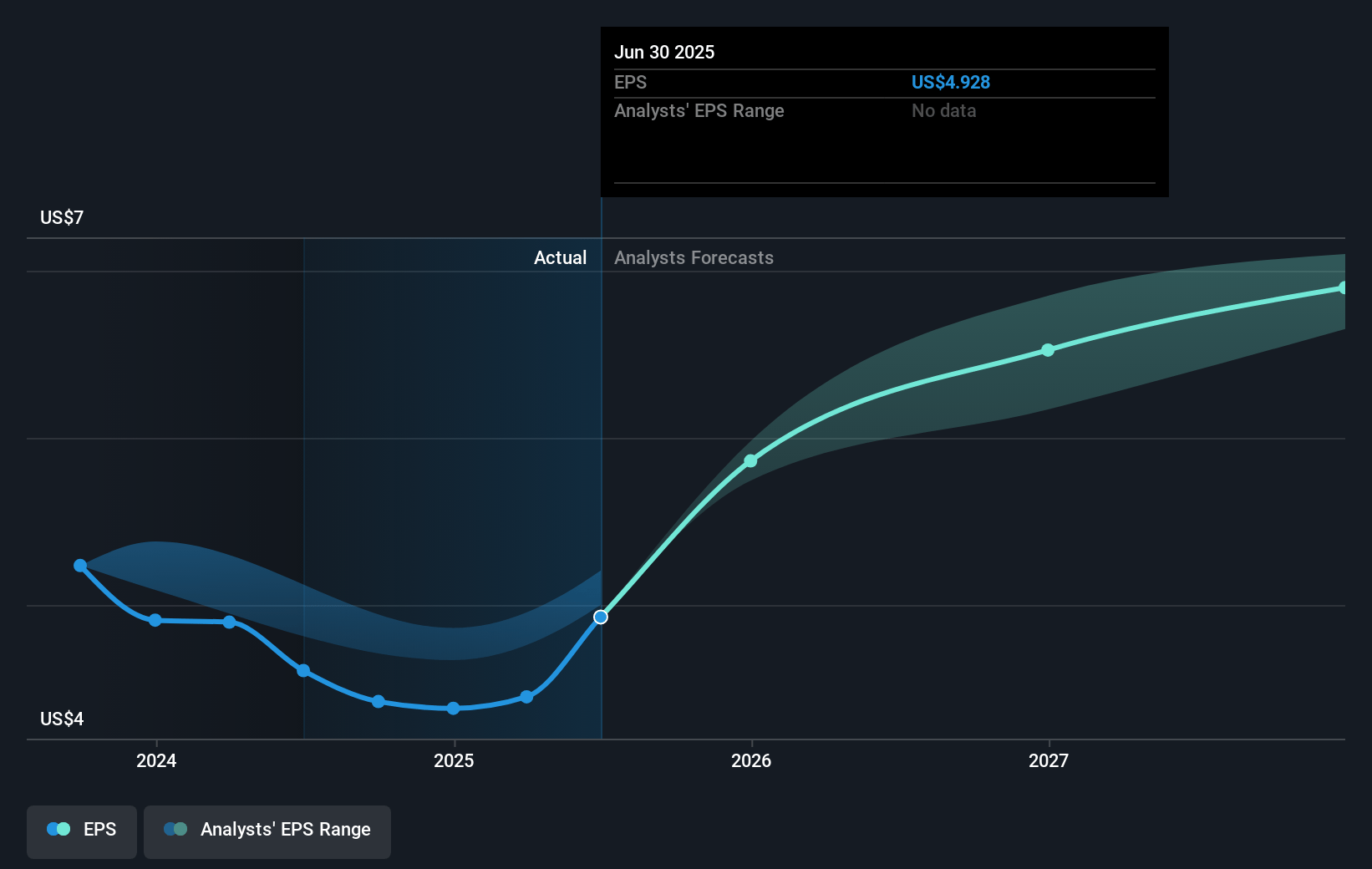Narratives are currently in beta
Key Takeaways
- Strategic balance sheet optimization enhances capital flexibility and supports revenue growth by expanding lending capacity and potential for share repurchases.
- Investments in technology and cybersecurity aim to boost efficiencies and net margins, while diversified deposit growth helps manage funding costs.
- Increased nonaccrual loans and charge-offs suggest potential risks in credit quality and revenue, impacting net earnings and noninterest income stability.
Catalysts
About Webster Financial- Operates as the bank holding company for Webster Bank, National Association that provides a range of financial products and services to individuals, families, and businesses in the United States.
- Strategic balance sheet optimization, including securitization and risk weighting adjustments, has increased capital flexibility and is expected to enhance earnings potential going forward. This should support revenue growth by allowing for additional lending capacity.
- The increase in capital ratios provides an opportunity for potential share repurchases, which can positively impact earnings per share (EPS) as capital is returned to shareholders.
- Continued investments in technology and cybersecurity are aimed at increasing efficiencies, which could result in improved net margins by reducing operating expenses in future periods.
- Diversified and versatile deposit growth, particularly in low-cost segments such as Health Savings Accounts (HSAs) and public funds, is expected to help manage funding costs and maintain strong net interest margins as interest rates decline.
- The proactive management of credit risk and improvement in capital levels may lead to more favorable loan growth dynamics, supporting higher revenue through an expanded lending portfolio while maintaining a strong credit profile.
Webster Financial Future Earnings and Revenue Growth
Assumptions
How have these above catalysts been quantified?- Analysts are assuming Webster Financial's revenue will grow by 10.9% annually over the next 3 years.
- Analysts assume that profit margins will increase from 31.7% today to 36.9% in 3 years time.
- Analysts expect earnings to reach $1.2 billion (and earnings per share of $7.46) by about November 2027, up from $751.8 million today.
- In order for the above numbers to justify the analysts price target, the company would need to trade at a PE ratio of 10.0x on those 2027 earnings, down from 13.7x today. This future PE is lower than the current PE for the US Banks industry at 12.8x.
- Analysts expect the number of shares outstanding to decline by 2.24% per year for the next 3 years.
- To value all of this in today's terms, we will use a discount rate of 5.99%, as per the Simply Wall St company report.
Webster Financial Future Earnings Per Share Growth
Risks
What could happen that would invalidate this narrative?- The increase in nonaccrual loans, particularly within the commercial real estate office portfolio, suggests the potential for higher future loan losses, which could negatively impact net earnings.
- The significant charge-offs from office loans and the adjustment in risk ratings imply a potential risk in credit quality across the portfolio, potentially affecting future provisions and net margins.
- The reduction in commercial real estate (CRE) concentration, while strategically beneficial, indicates possible exposure concerns and might constrain revenue growth in this sector.
- Seasonal variability in public fund deposits and the resulting cash position could lead to fluctuations in net interest income, impacting revenue consistency and financial stability.
- The pressure on core fee growth and adjustments related to securities and non-core operations may constrain noninterest income expansion, negatively impacting overall earnings.
Valuation
How have all the factors above been brought together to estimate a fair value?- The analysts have a consensus price target of $62.62 for Webster Financial based on their expectations of its future earnings growth, profit margins and other risk factors. However, there is a degree of disagreement amongst analysts, with the most bullish reporting a price target of $70.0, and the most bearish reporting a price target of just $58.0.
- In order for you to agree with the analyst's consensus, you'd need to believe that by 2027, revenues will be $3.2 billion, earnings will come to $1.2 billion, and it would be trading on a PE ratio of 10.0x, assuming you use a discount rate of 6.0%.
- Given the current share price of $59.96, the analyst's price target of $62.62 is 4.2% higher. The relatively low difference between the current share price and the analyst consensus price target indicates that they believe on average, the company is fairly priced.
- We always encourage you to reach your own conclusions though. So sense check these analyst numbers against your own assumptions and expectations based on your understanding of the business and what you believe is probable.
How well do narratives help inform your perspective?
Disclaimer
Warren A.I. is a tool utilizing a Large Language Model (LLM) that ingests data on consensus price targets, forecasted revenue and earnings figures, as well as the transcripts of earnings calls to produce qualitative analysis. The narratives produced by Warren A.I. are general in nature and are based solely on analyst data and publicly-available material published by the respective companies. These scenarios are not indicative of the company's future performance and are exploratory in nature. Simply Wall St has no position in the company(s) mentioned. The price targets and estimates used are consensus data, and do not constitute a recommendation to buy or sell any stock, and they do not take account of your objectives, or your financial situation. Note that Warren A.I.'s analysis may not factor in the latest price-sensitive company announcements or qualitative material.
Read more narratives
There are no other narratives for this company.
View all narratives



